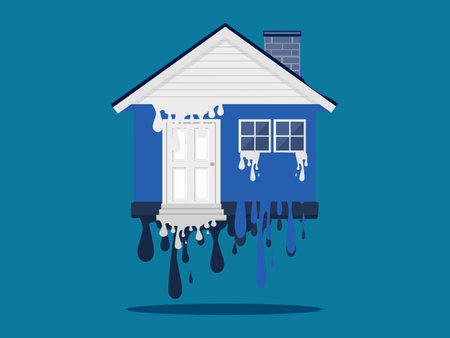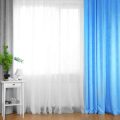Understanding Your Space
Before diving into curtain styles and fabrics, it’s essential to appreciate the distinct character of each room in your British home. British architecture is renowned for its diversity, from Victorian terraces with their high ceilings and sash windows to cosy cottages featuring lower beams and smaller panes. The function of a room—be it a restful bedroom, a sociable lounge, or a bustling kitchen—should guide your choices. Equally important is the quality and direction of natural light, which varies greatly with traditional north- or south-facing windows commonly found in UK homes. To help you analyse your space, consider the following:
| Room Type | Typical Features | Main Considerations |
|---|---|---|
| Lounge/Sitting Room | Large bay windows, decorative mouldings | Maximise light, maintain privacy, complement period features |
| Bedroom | Sash or casement windows, often facing gardens | Ensure darkness for sleep, provide thermal insulation |
| Kitchen | Smaller windows above counters or sinks | Easy to clean, allow ventilation, withstand humidity |
| Dining Room | French doors or large windows opening to patios | Add elegance, frame views, control glare during meals |
By taking stock of each room’s structure, how daylight moves through your home, and the specific activities that take place there, you lay the groundwork for choosing curtains that not only enhance aesthetics but also serve practical needs tailored to British living.
2. Selecting Fabrics for British Seasons
When curating curtains for your British home, understanding the unique demands of the UK’s ever-shifting weather is key. The right fabric can transform not only the ambience of your space but also its comfort and energy efficiency throughout the year. Let’s explore how to select materials that complement both traditional British interiors and unpredictable local climates.
Considering the British Climate
Britain is renowned for its temperamental weather—sunshine one moment, rain the next, and plenty of chilly evenings even in spring or autumn. This makes fabric selection a thoughtful process, balancing insulation with breathability and style.
Fabric Choices: Pros and Cons for Every Season
| Fabric Type | Best For | Benefits | Drawbacks |
|---|---|---|---|
| Velvet | Winter & Drafty Rooms | Excellent insulation, luxurious appearance, blocks draughts | Can feel heavy or dark in small spaces; less breathable in summer |
| Linen | Spring/Summer & Light-filled Rooms | Breezy and light, allows gentle sunlight, elegant drape | Less effective at insulating against cold; may crease easily |
| Cotton Blends | All Year Round & Versatile Spaces | Adaptable, easy to clean, wide range of prints and colours | Might not provide full blackout or thermal benefits unless lined |
| Tweed/Wool Mixes | Period Homes & Autumn/Winter | Adds texture and warmth, quintessentially British look | Tends to be heavier; can retain dust if not regularly cleaned |
Pro Tip:
If you crave flexibility, opt for layered window treatments—pairing lightweight sheers with heavier curtains lets you adapt effortlessly as British weather changes.

3. Colour Schemes and Patterns Inspired by British Aesthetics
When selecting curtains for your British home, colour coordination is essential to achieving a cohesive and inviting atmosphere. Classic British interiors are renowned for their timeless palettes—think subtle greys, warm taupes, sage greens, and soft blues—combined with signature patterns that pay homage to the nation’s heritage. To create an interior that feels both current and rooted in tradition, consider how each room’s purpose and existing décor can be complemented by your curtain choice.
Classic British Colour Palettes
| Palette Name | Key Colours | Best Room Applications |
|---|---|---|
| Understated Neutrals | Cream, oatmeal, dove grey | Living rooms, bedrooms |
| Regal Blues & Greens | Navy, duck egg blue, sage green | Dining rooms, studies |
| Warm Earthy Tones | Terracotta, olive, mushroom brown | Kitchens, entryways |
Heritage Prints & Textures
British homes often feature prints that reflect a sense of history and character. Look for classic motifs such as florals inspired by English gardens, tartans reminiscent of the countryside, or understated stripes for a nautical touch. Pairing these with natural fabrics—linen, cotton blends, or even wool—adds depth and authenticity to your windows.
Tips for Coordinating Curtains with Your Interior
- If your furniture and walls are neutral, choose patterned curtains to add personality without overwhelming the space.
- For richly coloured walls or statement wallpaper, select plain curtains in complementary hues to maintain balance.
- Layering sheer voiles beneath heavier drapes allows you to play with texture and light while keeping to your chosen palette.
Create Cohesion Across Rooms
A harmonious home doesn’t mean every room must match perfectly; instead, carry a thread of consistency through repeating tones or prints in different scales. Whether you favour the refined elegance of muted shades or the boldness of classic checks and florals, ensuring your curtain choices echo the broader aesthetic of your British home brings unity and charm throughout.
4. Embracing Traditional and Modern Curtain Styles
When selecting curtains for your British home, striking the right balance between tradition and modernity can elevate your interiors beautifully. The UK is renowned for its charming period properties, where classic curtain styles like pinch pleats and swags complement original features such as bay windows, decorative cornicing, or ornate fireplaces. These timeless designs bring a sense of heritage and warmth, making them ideal for Victorian terraces, Georgian townhouses, or countryside cottages.
Comparing Traditional vs. Modern Curtain Styles
| Style | Best For | Key Features | Room Suggestions |
|---|---|---|---|
| Pinch Pleats | Period Properties | Elegant folds, structured look, classic detailing | Lounge, dining room, master bedroom |
| Swags & Tails | Grand Spaces | Draped fabric, formal appearance, statement style | Drawing room, formal living areas |
| Minimalist Eyelets | Modern Homes & Flats | Sleek lines, easy movement, understated chic | Open-plan living spaces, contemporary bedrooms |
| Wave Curtains | Architectural Spaces | Soft undulating folds, casual yet smart finish | Kitchens with bi-fold doors, modern extensions |
Selecting the Right Style for Each Room
If you have a period property: Opt for pinch pleats or swags to enhance original features and create a cohesive heritage look. Choose rich fabrics like velvet or heavy linen in deep tones or subtle florals for that quintessential British feel.
If you prefer a modern aesthetic: Consider minimalist eyelet or wave curtains in neutral shades or bold prints for a fresh update. Lightweight cottons and linens work well in light-filled spaces, offering a contemporary twist without overpowering the room.
The Power of Contrast and Layering
For the best of both worlds, try layering traditional curtains with modern sheer panels or roller blinds. This approach not only provides flexibility in light control but also allows you to play with textures and patterns—perfect for adding character to any British home.
5. Practical Considerations: Privacy, Light Control, and Energy Efficiency
When selecting curtains for your British home, its essential to balance style with practicality. Urban living in the UK often means houses are closely situated, making privacy a key consideration—particularly in ground floor rooms or bedrooms overlooking the street. The right curtain choice offers a comforting retreat from passing glances while still letting your space breathe.
Privacy Matters in Urban Settings
For many British homeowners, privacy is not just a luxury but a necessity. Sheer voiles or lightweight fabrics allow daylight to filter through while obscuring the view from outside. For areas requiring greater seclusion—such as bathrooms or bedrooms—opt for heavier or blackout curtain linings. Layering curtains is another popular technique across Britain, providing both flexibility and peace of mind.
Managing Daylight: The Art of Light Control
The UKs ever-changing weather means maximising natural light is vital, especially during gloomy winter months. Curtains can help you manage sunlight effectively throughout the day. Lighter shades brighten interiors and create an airy atmosphere, while thicker materials can keep rooms cosy and shielded from harsh afternoon sun. Consider dual-layer systems that combine sheer panels with heavier drapes for ultimate adaptability.
Energy Efficiency: Draught Proofing with Curtains
Bespoke curtains do more than elevate your interiors—they also support sustainable living by improving energy efficiency. Well-fitted curtains act as an extra barrier against heat loss through windows, helping maintain warmth during chilly British winters and reducing energy bills. Thermal linings or interlined curtains are particularly effective in older properties prone to draughts.
Curtain Choices for Practical Needs
| Room | Privacy Level | Light Control | Draught Proofing |
|---|---|---|---|
| Lounge | Medium | Lined curtains with sheers | Heavyweight drapes, thermal lining |
| Bedroom | High | Blackout curtains | Interlined curtains |
| Kitchen | Low-Medium | Café curtains, voiles | N/A or lightweight lining |
Expert Tip:
Avoid leaving gaps between the curtain fabric and window frame to maximise insulation—a small detail that makes a big difference in British homes.
6. Measuring, Fitting, and Finishing Touches
Getting the perfect curtains for your British home isn’t just about fabric and colour—it’s also about ensuring they fit beautifully and have those thoughtful details that elevate your space. Here’s how to measure, fit, and finish your curtains for a truly bespoke look.
Measuring British Windows: A Step-by-Step Guide
Whether you live in a classic Victorian terrace or a modern flat, British windows come in all shapes and sizes. Accurate measuring is essential for a tailored fit. Use the table below as a handy guide:
| Window Type | Where to Measure | Top Tip |
|---|---|---|
| Sash Window | Measure width from outer frame to frame; height from just above the window to desired curtain drop (usually just below sill or to the floor) | Add 15-20cm on each side for fullness |
| Bay Window | Measure each section individually; consider curved rails for seamless drape | Mark all bends accurately for a snug fit |
| Cottage Window | Measure close to the frame for a cosy effect; usually choose shorter drops to sit on the sill | Café-style curtains add character and privacy |
Choosing the Right Hardware
The right curtain poles or tracks are essential. In Britain, wooden poles suit period homes while sleek metal rods complement contemporary spaces. Always ensure your hardware extends beyond the window frame by at least 15cm on each side so your curtains can stack neatly when open. Consider brackets, finials, and hooks that echo other finishes in your room—brass, black iron, or painted wood are perennial favourites.
Add Thoughtful Finishing Details
The difference between ordinary and show-stopping often lies in the finishing touches. Here are some classic British details to consider:
- Tiebacks: Traditional rope or tassel tiebacks create a refined look, while fabric bands offer understated elegance. Try vintage-inspired options for period homes.
- Pelmets: A well-upholstered pelmet hides curtain headings and adds architectural interest—ideal for draughty sash windows or grand bay windows.
- Trims & Borders: Contrast piping, velvet bands, or heritage braids give plain curtains a designer edge. Match trims to cushions or throws for cohesive styling.
Final Styling Tips:
- Allow curtains to just kiss the floor for a tailored finish, or let them puddle slightly in formal settings.
- If layering with blinds or sheers, hang curtain poles higher than the window frame to create an illusion of height—a favourite trick in many British homes.
- Don’t forget blackout linings in bedrooms and thermal linings for draughty older properties.
The right measurements, fitting, and finishing touches not only ensure functionality but also bring a layer of comfort and sophistication unique to every British home.


